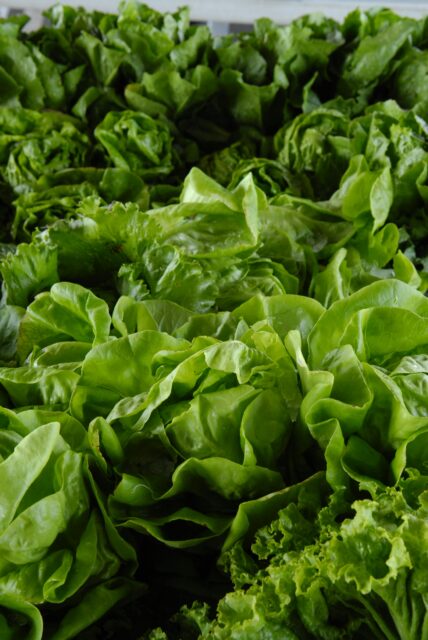Lettuce is a widely consumed leaf because it’s low in calories and high in fiber, and it is also packed with essential vitamins and minerals. From the classic iceberg lettuce to the more exotic mizuna and radicchio, there’s a lettuce variety out there for everyone.
Lettuce is a leafy vegetable, famous for giving salads their base. There are multiple types of lettuce, and they all share the scientific name “Lactuca sativa”.
The health benefits of lettuce come primarily from its vitamin content. Health benefits vary depending on the type of lettuce a person eats.
These vegetables are most often served raw, dressed and tossed with other salad ingredients. Whether you’re using them raw or cooked, though, different types of lettuce can add quite a bit of texture and flavor to whatever you’re making.
Types Of Lettuce Leaf
1. Butterhead Lettuce

Also known as Butter lettuce, Boston, bibb (limestone), Mignonette, and Buttercrunch lettuce
These types of leaves, Boston and bibb lettuce, are soft. And as this variety’s name implies, the texture of butter lettuce is indeed smooth, like butter. Bibb is the more expensive of the two and is often sold in a plastic container to protect the delicate leaves.
The tender leaves of butter lettuce work best in delicate salads, but their broad, flexible leaves can also be used as a wrap.
2. Arugula

Also known as Rocket, Italian cress, Mediterranean rocket, rugola, rugula, roquette, and rucola, this green tastes earthy and slightly tart with a bold, peppery kick.
The shape of an arugula leaf is similar to oakleaf lettuce, with rounded edges that undulate from broad to slight. The edges of baby arugula aren’t as defined.
Arugula can be eaten raw, in bold-flavored salads, wilted into pasta, cooked into a gratin, or blended into a pesto-like spread.
3. Coral lettuce
It can also be called Lollo Rosso, Lollo Bionda. Coral is a looseleaf variety and can be bright green, deep red, or speckled. The sturdy, crisp leaves have tight, frilly curls and a mild flavor.
The tight curls of coral lettuce are adept at trapping dressing. The crisp but tender variety also makes a great sandwich or burger lettuce.
4. Cress

Also known as water cress, upland cress, curly cress, and land cress. It has a peppery taste characteristic of all varieties. Sold in bunches, mature watercress has a tough, fibrous stem and small green leaves (the stems of baby watercress are generally more tender). Be sure to wash all forms of cress thoroughly, since they often grow in sandy ground.
Cress has a bold flavor but delicate texture. Use it in sophisticated-but-simple side salads, toss them into a saucy noodle dish, or use them to top a spring pizza.
5. Endive
Also known as Belgian endive, French endive, witloof, witloof chicory, Belgium
chicory. The unique oval shape, soft, satiny texture and slight bitterness all mean it’s a great addition to any salad. It’s scooplike shape makes for edible servers, perfect for small appetizers.
6. Frisée
It is also called Curly endive, chicory endive, curly chicory. These curled leaves, tinged with yellow and green, are slightly bitter in taste, have a crunchy stem and add a lot of texture.
Their pale green, white, and yellow coloring is a result of the producer shielding them from light during the growing process. Frisée is closely related to escarole. Frisée’s frilly texture is best enjoyed raw or slightly warmed through.
7. Little Gem lettuce
It can also be called Sucrine, Sugar Cos, baby gem. Little Gem lettuce resembles baby romaine; it’s actually a full-grown variety. The leaves are crisp, sweet and sturdy.
Its small stature means the leaves are ready to be tossed whole into a salad. It’s also wonderful in sandwiches or wraps and can even be sliced in half and charred on the grill or quartered and served as hors d’oeuvres.
8. Escarole
Also known as Batavian endive, scarole, broad-leaved endive. This mildly bitter leafy green is large and crisp. Escarole is often used in soups and paired with beans, reflecting its popularity in Italian cuisine.
Escarole is delicious raw, in salads, or cooked, especially when paired with beans in a stew.
9. Iceberg lettuce

It is also called Crisphead, Reine de Glace, and Igloo lettuce. Iceberg are known for being very crisp, watery, and refreshing. It forms in basketball-sized heads with large, tightly packed, pale-green leaves.
Iceberg lettuce is the gold-standard for a chopped salad or wedge salad. It also adds a satisfying crisp, cool texture when shredded and stuffed into tacos, subs, and fried fish sandwiches.
10. Loose Leaf lettuce
It is also known as Batavia lettuce, leaf lettuce, green leaf lettuce, red leaf lettuce, Redina. They have a mild flavor and are very pliable, despite the crunchy stem. Their uneven, ruffled surfaces add layers of texture to salads.
Loose Leaf lettuce can go wherever you want it to go. Because the leaves are so large, it’s best to tear them up into bite-size pieces for salad. They’re also great puréed into soup and the broad, tender leaves combined with the sturdy rib make for exceptional lettuce wraps.
11. Mesclun
It is also called Mixed baby lettuce or spring mix. Mesclun is not a specific type of lettuce but rather a loose mix of tender baby lettuce leaves. The mix might contain any number of lettuce varieties, as well as baby spinach or other baby greens.
Pre-packaged mesclun mixes can be hit-or-miss, so if you’re looking for a variety, it might be best to choose a few different types on this list and mix them together once you’re home.
12. Mâche
It is also called Field salad, lamb’s lettuce, corn salad, field lettuce, fetticus. Mâche can sometimes be sold with its soil still attached; this salad green imparts a mild and slightly sweet flavor to a salad.
Because of the small size of the leaves, trying to create a whole salad with a base of mâche can be expensive. Its leaves are also very delicate and will bruise easily, so handle with care. This tender green is best reserved for special-occasion salads.
13. Romaine lettuce

It is also called Cos lettuce. This large leafy lettuce is stiffer than most, and a thick center rib gives it a real crunch. The rib also gives this lettuce a slight bitter taste. This is the lettuce originally used when the Caesar salad was created.
You can make use of Romaine whenever you want superior crunch from your greens or a sturdy variety that can stand up to the grill.
14. Stem lettuce
Also called celery lettuce, asparagus lettuce, Chinese lettuce, wosun and stalk lettuce. Stem lettuce has floppy leaves and is edible; the real prize here is the stalk of this lettuce variety. The leaves can be bitter, like escarole, but the stalk, which should be peeled, has a nutty, cucumber-like flavor.
The leaves can be eaten like any other lettuce variety, raw or wilted into soups. The stalks can be sliced thin and eaten raw or added to a stir-fry, grilled, or cooked any way you might prepare asparagus or broccoli stems (such as in a frittata).
15. Speckled lettuce
It is also called Speckled trout lettuce or Thorburn’s orchid lettuce. Many varieties on this list, including romaine, looseleaf, and butterhead, could all come with a speckled pattern on its leaves. The bold coloring usually indicates that the lettuce in question is an heirloom or cross-bread variety.
Keep these leaves whole or tear them into large pieces and toss in a salad that shows off their unique appearance.
16. Radicchio
It is also called Chioggia, red chicory, red leaf chicory, red Italian chicory, Castlefranco. you can find this deep-red-purple vegetable sold either as a compact round head or shaped like its relative, endive. The bright coloring makes it stand out.
For lovers of bitter lettuce, this essential chicory is crisp and velvety when eaten raw. It can be a stand-alone salad green or mixed with other chicories or sweet lettuces. When cooked, the red-purple hue turns brown and what was once bitter becomes sweet.
17. Oakleaf lettuce
The shape of this butter lettuce’s leaves are similar to that of the oak tree, thus its name. From a distance, one could mistake it for red leaf and green loose leaf lettuce, but a closer look will reveal differences in shape and texture. This type of lettuce has leaves that are a little shorter and more squat, and the tops of their leaves have a softer texture than their red leaf and green leaf counterparts.
This delicate, tender lettuce acts as a great bed for other ingredients and won’t compete with other flavors.
Benefits of Lettuce Leaf
Lettuce is an excellent source of beta-carotene (vitamin A) which is needed for healthy skin, bones and eyes. Lettuce is a fair source of folate, which is needed for healthy cells and the healthy growth of babies during pregnancy in order to prevent neural tube defects.
Health Benefits
The health benefits of lettuce vary across varieties based on their nutritional contents. Iceberg lettuce is generally the lettuce type with the lowest amount of nutrients.
1. It helps in Bone Strength
Lettuce is a source of vitamin K, which helps strengthen bones. Consuming adequate amounts of vitamin K can also reduce your risk of bone fracture.
2. It helps Hydration
Water makes up over 95% of raw lettuce. As a result, eating lettuce hydrates the body. Although drinking liquids is necessary, water in foods can also significantly contribute to hydration.
3. It Helps Improves Vision
Lettuce is a source of vitamin A, which plays a role in eye health. Vitamin A can reduce a person’s risk of cataracts. Vitamin A also helps prevent macular degeneration.
4. It Helps Improves Sleep
Extracts of multiple lettuce types have also been shown to promote sleep. Until further research is conducted, it’s unknown if lettuce in its natural form can produce a similar effect.
Conclusion
Lettuce is generally a rich source of vitamins K and A, though the nutritional quality varies, depending on the variety.




